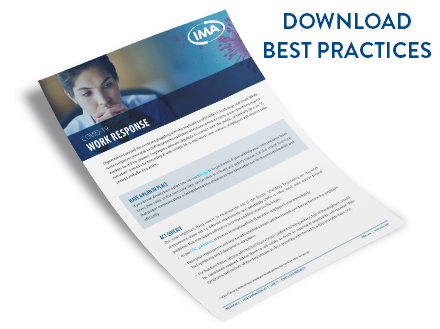COVID-19
What to do if an Employee Gets COVID-19
While some companies were able to shift large portions of their workforce to remote work, some operations require workers to still be present.
What to do if an Employee Gets COVID-19
Organizations around the world are grappling with the implications of COVID-19, both large and small. While some companies were able to shift large portions of their workforce to remote work, some operations require workers to still be present. Employees who are regularly in contact with the public, potentially face an “if, not when” scenario for becoming ill with COVID-19. In that worst-case scenario, employers will need to take prompt and effective action.
Have a plan in place
If you do not already have a plan, you can use this guide to get started. A plan will help your crisis response team know their roles, so that necessary steps can be taken in a timely and orderly manner. It is also critical to ensure that proper communications is taking place across channels so new information can be disseminated quickly and efficiently.
Do not violate your employee’s confidentiality
While you must disclose the presence of COVID-19 to everyone who was possibly exposed to the virus, privacy laws require you do so without exposing the individual employee’s identity.[1]
Act quickly
The most important thing now is to minimize the risk of the disease spreading. Depending on the work environment, there will be different requirements and potentially OSHA or other local, state and/or federal guidelines that may require adherence to or that could be issued in the future. [2]
- As per CDC guidelines, as soon as an employee feels ill, send the employee home immediately [3]
- Have your employee recount anyone with who had contact with the ill employee during the time the employee had symptoms and 2 days prior to symptoms.
- For that time frame, anyone who has had “close contact”, defined as being within 6 feet of the employee, would be considered exposed. Advise them to self-isolate as much as reasonably practicable, self-monitor their symptoms, and recount whom they’ve been in close proximity with the last few days to notify them, too.[4]
Disinfect and Clean Workspaces
Surfaces in their workspace should be cleaned and disinfected.[5]
Once the employee returns to work
Pre-Screen: Employers should measure the employee’s temperature and assess symptoms prior to them starting work. Ideally, temperature checks should happen before the individual enters the facility.
Regular Monitoring: As long as the employee doesn’t have a temperature or symptoms, they should self-monitor under the supervision of their employer’s occupational health program.
Wear a Mask: The employee should wear a face mask at all times while in the workplace for 14 days after last exposure. Employers can issue facemasks or can approve employees’ supplied cloth face coverings in the event of shortages.
Social Distance: The employee should maintain 6 feet and practice social distancing as work duties permit in the workplace.[6]
Please be advised that this whitepaper is an educational and informational resource only. The views and statements expressed herein are not to be construed as legal advice from the authors or IMA and such communication is not protected under the attorney client privilege. Recipients should seek specific legal advice from competent legal counsel of your choice.
